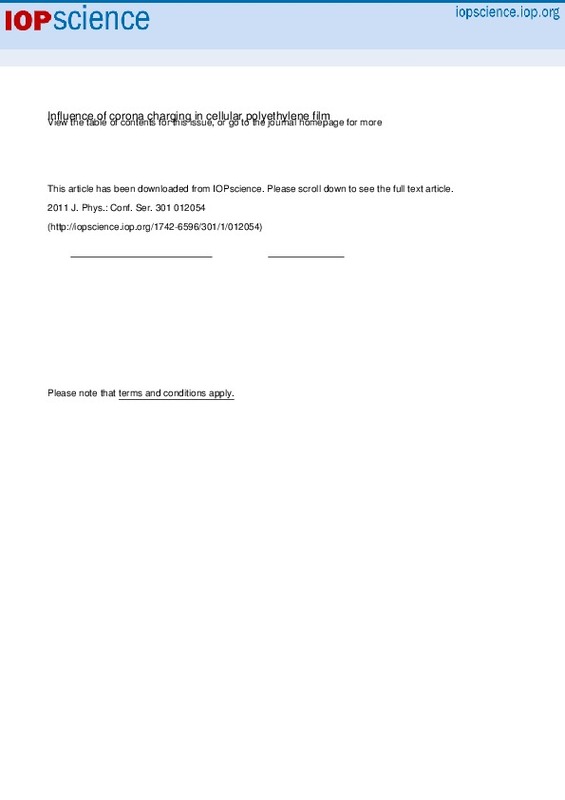JavaScript is disabled for your browser. Some features of this site may not work without it.
Buscar en RiuNet
Listar
Mi cuenta
Estadísticas
Ayuda RiuNet
Admin. UPV
Influence of corona charging in cellular polyethlene film
Mostrar el registro sencillo del ítem
Ficheros en el ítem
| dc.contributor.author | Ortega Braña, Gustavo Eloy
|
es_ES |
| dc.contributor.author | Llovera Segovia, Pedro
|
es_ES |
| dc.contributor.author | Magraner Bella, Francisco
|
es_ES |
| dc.contributor.author | Quijano Lopez, Alfredo
|
es_ES |
| dc.date.accessioned | 2013-04-29T11:59:16Z | |
| dc.date.available | 2013-04-29T11:59:16Z | |
| dc.date.issued | 2011 | |
| dc.identifier.issn | 1742-6588 | |
| dc.identifier.uri | http://hdl.handle.net/10251/28310 | |
| dc.description.abstract | [En] Cellular polymers have recently attracted attention for their property of exhibiting a piezoelectric constant when they are electrically charged. The electrostatic charge generated in the voids by the internal discharges creates and internal macrodipole which is responsible for the piezoelectric effect. Charging by corona discharge is the most used method for cellular polymers. Many works has been published on polypropylene and polyethylene films mainly focused on the required expansion process or on the results obtained for raw cellular materials electrically activated. Our work is based on commercial polyethylene cellular films which have been physically characterized and electrically activated. The effect of thermal treatment, physical uniaxial or biaxial stretching and corona charging was investigated. The new method of corona charging improved the piezoelectric constant under other activation conditions. | es_ES |
| dc.description.sponsorship | This work has been developed under the project Intelligent Materials with Mechanical and Electrical Properties interaction (E-MAT)" which has been submitted for funding with reference number IMDEEA/2011/13 to the call of Technological Centers of IMPIVA Network 2011, Strategic development program (action 1, R+D projects) financed by the Generalitat Valenciana through the Instituto de la Mediana y Pequena Empresa Valenciana (IMPIVA) and the European Regional Development Fund (ERDF). | |
| dc.language | Inglés | es_ES |
| dc.publisher | IOP Publishing: Conference Series | es_ES |
| dc.relation.ispartof | Journal of Physics: Conference Series | es_ES |
| dc.rights | Reconocimiento (by) | es_ES |
| dc.subject.classification | INGENIERIA ELECTRICA | es_ES |
| dc.title | Influence of corona charging in cellular polyethlene film | es_ES |
| dc.type | Artículo | es_ES |
| dc.type | Comunicación en congreso | |
| dc.identifier.doi | 10.1088/1742-6596/301/1/012054 | |
| dc.relation.projectID | info:eu-repo/grantAgreement/IMPIVA//IMDEEA%2F2011%2F13/ES/MATERIALES INTELIGENTES CON INTERACCIÓN PROPIEDADES ELÉCTRICAS Y MECÁNICAS (E-MAT)/ | es_ES |
| dc.rights.accessRights | Abierto | es_ES |
| dc.contributor.affiliation | Universitat Politècnica de València. Departamento de Ingeniería Eléctrica - Departament d'Enginyeria Elèctrica | es_ES |
| dc.contributor.affiliation | Universitat Politècnica de València. Instituto de Tecnología Eléctrica - Institut de Tecnologia Elèctrica | es_ES |
| dc.description.bibliographicCitation | Ortega Braña, GE.; Llovera Segovia, P.; Magraner Bella, F.; Quijano Lopez, A. (2011). Influence of corona charging in cellular polyethlene film. Journal of Physics: Conference Series. 301:1-4. https://doi.org/10.1088/1742-6596/301/1/012054 | es_ES |
| dc.description.accrualMethod | S | es_ES |
| dc.relation.conferencename | 13th International Conference on Electrostatics | |
| dc.relation.conferencedate | April 10-14, 2011 | |
| dc.relation.conferenceplace | Bangor, Wales | |
| dc.relation.publisherversion | http://dx.doi.org/10.1088/1742-6596/301/1/012054 | es_ES |
| dc.description.upvformatpinicio | 1 | es_ES |
| dc.description.upvformatpfin | 4 | es_ES |
| dc.type.version | info:eu-repo/semantics/publishedVersion | es_ES |
| dc.description.volume | 301 | es_ES |
| dc.relation.senia | 213596 | |
| dc.contributor.funder | Instituto de la Pequeña y Mediana Industria de la Generalitat Valenciana | |
| dc.description.references | Fukada, E. (2000). History and recent progress in piezoelectric polymers. IEEE Transactions on Ultrasonics, Ferroelectrics and Frequency Control, 47(6), 1277-1290. doi:10.1109/58.883516 | es_ES |
| dc.description.references | Sessler, G. M., & Hillenbrand, J. (1999). Electromechanical response of cellular electret films. Applied Physics Letters, 75(21), 3405-3407. doi:10.1063/1.125308 | es_ES |
| dc.description.references | Hillenbrand, J., & Sessler, G. M. (2000). Piezoelectricity in cellular electret films. IEEE Transactions on Dielectrics and Electrical Insulation, 7(4), 537-542. doi:10.1109/94.868074 | es_ES |
| dc.description.references | Paajanen, M., Välimäki, H., & Lekkala, J. (2000). Modelling the electromechanical film (EMFi). Journal of Electrostatics, 48(3-4), 193-204. doi:10.1016/s0304-3886(99)00065-0 | es_ES |
| dc.description.references | Gerhard-Multhaupt, R. (2002). Less can be more. Holes in polymers lead to a new paradigm of piezoelectric materials for electret transducers. IEEE Transactions on Dielectrics and Electrical Insulation, 9(5), 850-859. doi:10.1109/tdei.2002.1038668 | es_ES |
| dc.description.references | Wegener, M., & Bauer, S. (2005). Microstorms in Cellular Polymers: A Route to Soft Piezoelectric Transducer Materials with Engineered Macroscopic Dipoles. ChemPhysChem, 6(6), 1014-1025. doi:10.1002/cphc.200400517 | es_ES |
| dc.description.references | Hillenbrand, J., Behrendt, N., Mohmeyer, N., Altsadt, V., Schmidt, H.-W., & Sessler, G. M. (s. f.). Charge retention in biaxially-oriented polypropylene films containing various additives. 2005 12th International Symposium on Electrets. doi:10.1109/ise.2005.1612375 | es_ES |
| dc.description.references | Xiaoqing Zhang, Sessler, G. M., & Hillenbrand, J. (s. f.). Optimization of Piezoelectric Properties of Cellular Polypropylene Films by Repeated Expansion. 2005 12th International Symposium on Electrets. doi:10.1109/ise.2005.1612316 | es_ES |








